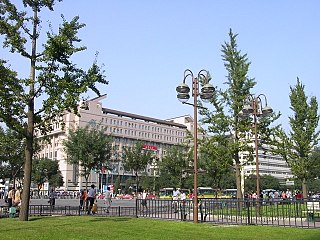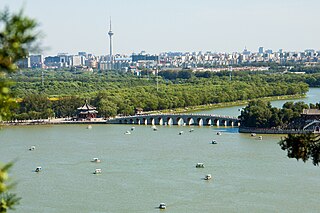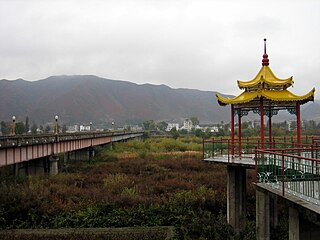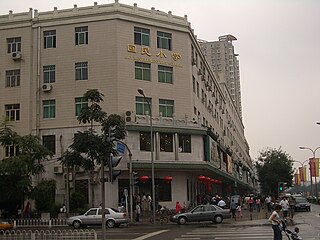
Wuchang forms part of the urban core of and is one of 13 urban districts of the prefecture-level city of Wuhan, the capital of Hubei Province, China. It is the oldest of the three cities that merged into modern-day Wuhan, and stood on the right (southeastern) bank of the Yangtze River, opposite the mouth of the Han River. The two other cities, Hanyang and Hankou, were on the left (northwestern) bank, separated from each other by the Han River.

Hotan is a major oasis town in southwestern Xinjiang, an autonomous region in Western China. The city proper of Hotan broke off from the larger Hotan County to become an administrative area in its own right in August 1984. It is the seat of Hotan Prefecture.

Chaoyang District is a core district of Beijing. It borders the districts of Shunyi to the northeast, Tongzhou to the east and southeast, Daxing to the south, Fengtai to the southwest, Dongcheng, Xicheng and Haidian to the west, and Changping to the northwest.

Xicheng District is a district of Beijing. Xicheng District spans 32 square kilometres (12 sq mi), making it the largest portion of the old city, and has 706,691 inhabitants. Its postal code is 100032. Xicheng is subdivided into 15 subdistricts of the city proper of Beijing. The former Xuanwu District was merged into Xicheng in July 2010.

Haidian District is a district of the municipality of Beijing. It is mostly situated in northwestern Beijing, but also to a lesser extent in the west, where it has borders with Xicheng District and Fengtai District.

Yiwu is a county-level city under the jurisdiction of Jinhua in central Zhejiang province, East China. The city has about 1.2 million people, and its urban area, joined with that of the neighboring Dongyang, was home to 2,038,413 inhabitants according to the 2010 census. The city is famous for its light industry commodity trade and vibrant market, and as a regional tourist destination.

The Niujie Mosque(simplified Chinese: 牛街礼拜寺; traditional Chinese: 牛街禮拜寺; pinyin: Niú Jiē Lǐ Bài Sì; Wade–Giles: Niu-chieh Li-pai-ssu "Oxen Street House of Worship" or Chinese: 牛街清真寺; pinyin: Niú Jiē Qīng Zhēn Sì; Wade–Giles: Niu-chieh Ch'ing-chen-ssu "Oxen Street Mosque") is the oldest mosque in Beijing, China. It was first built in 996 during the Liao Dynasty and was reconstructed as well as enlarged under the Kangxi Emperor of the Qing Dynasty.

Zhongguancun is a technology hub in Haidian District, Beijing, China.

Sanhe is a county-level city administered by Langfang prefecture in eastern Hebei province, People's Republic of China. Sanhe city, Dachang Hui Autonomous County, and Xianghe County form the "Northern Three Counties of Langfang", an exclave of Hebei province surrounded by the Beijing and Tianjin municipalities.

Tumen is a county-level city in Yanbian Korean Autonomous Prefecture, eastern Jilin province, Northeast China. Of its 136,000 inhabitants, approximately 78,000 are of Korean descent. The two official languages are Chinese and Korean. Tumen is separated from Namyang of North Hamgyong province of North Korea by the Tumen River. Due to this proximity, many North Koreans escaping North Korea pass through Tumen. Tumen is also the location of a large detention center for captured North Koreans awaiting deportation. Tumen has two major food markets, the South Market and the North Market, where most of the residents purchase their food. Packaged foods and meats are usually sold inside the building, and vegetables are sold outside. There are six elementary schools, with three Korean schools, and three Chinese schools.

Old Town Chinatown is the official Chinatown of the Northwest section of Portland, Oregon. The Willamette River forms its eastern boundary, separating it from the Lloyd District and the Kerns and Buckman neighborhoods. It includes the Portland Skidmore/Old Town Historic District and the Portland New Chinatown/Japantown Historic District, which are listed on the National Register of Historic Places. It has been referred to as the "skid row" of Portland.

The China World Trade Center is located in Chaoyang District, the central business district of Beijing.

Enshi is a county-level city in and the seat of Enshi Tujia and Miao Autonomous Prefecture, in western Hubei province, People's Republic of China. The prefecture's legislature, executive and judiciary are seated here, as well as its CPC and Public security bureau.

Zhuozhou, is a county-level city with 628,000 inhabitants in Hebei province, bordering Beijing to the north. It is administered by Baoding prefecture-level city. Zhuozhou has 3 subdistricts, 6 towns, 5 townships, and 1 development zone.

Niujie is a neighborhood at Guang'anmen, in Xicheng District in southwest Beijing, China. The name "Niujie" can refer to the street Niujie or to the neighborhood Niujie. The community was previously in Xuanwu District before the district was merged into Xicheng in 2010.

Beijing, alternatively romanized as Peking, is the capital of the People's Republic of China. It is the world's most populous capital city, with over 21 million residents within an administrative area of 16,410.5 km2. The city, located in Northern China, is governed as a municipality under the direct administration of the State Council with 16 urban, suburban, and rural districts. Beijing is mostly surrounded by Hebei Province with the exception of neighboring Tianjin to the southeast; together, the three divisions form the Jingjinji megalopolis and the national capital region of China.

Jiang'an District forms part of the urban core of and is one of 13 urban districts of the prefecture-level city of Wuhan, the capital of Hubei Province, China.

Gaizhou, formerly Gaixian, Gaiping, and Kaiping, is a county-level city in Liaoning province, China. It is under the administration of Yingkou City, which lies 31 km (19 mi) to the north-northwest, and is located at the northwest end of the Liaodong Peninsula near the northeast coast of the Bohai Sea.

Silk Street, aka Silk Market or Silk Street Market, is a shopping center in Chaoyang District, Beijing, that accommodates over 1,700 retail vendors, notorious among international tourists for their wide selection of counterfeit designer brand apparel. The Silk Street is located at Yonganli, just west of the China World Trade Centre and is accessible by subway and bus.
Pakistan Embassy College Beijing is a Pakistan International School located on the Embassy of Pakistan compound in Sanlitun, Chaoyang District, Beijing. It serves students ages 4–19, in Kindergarten through senior school.



















